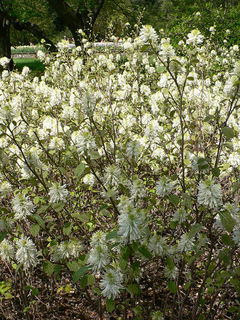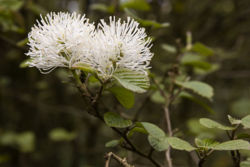Fothergilla
| Standard Cyclopedia of Horticulture |
|---|
|
Fothergilla (after John Fothergill, eminent English physician, who introduced and cultivated many new plants, 1712-1780). Hamameliddaceae. Dwarf Alder. Shrubs, chiefly grown for their showy spikes of white flowers and also for the handsome foliage. Deciduous, more or less stellate-pubescent: lvs. alternate, short-petioled, coarsely toothed, stipulate: fls. in terminal spikes, perfect, apetalous; calyx campanulate, 5-7-lobed; stamens numerous, with the filaments thickened toward the end: caps, dehiscent, 2-celled and 2-seeded.—Four species in the. southern Atlantic states. These are hardy ornamental shrubs with simple, dull green leaves, and showy spikes of white flowers in spring with the leaves: the distinct foliage resembles somewhat that of the alder, or more that of Hamamelis, and turns yellow late in fall. They grow best in moist, peaty or sandy soil. Propagation is by seeds, not germinating until the second year, or by layers, which take two years to root; the first species also by suckers and root-cuttings. F. parviflora, Kearney. Closely related to F. gardenii. Lower and stoloniferous: lvs. nearly orbicular, rounded or cordate at the base, toothed from below the middle. N. C. to Fla.
|
| Fothergilla {{{status}}} Fossil range: {{{fossil_range}}}
| ||||||||||||||||||||||||||||||||||||||||||||||||||||||||||||||||||
|---|---|---|---|---|---|---|---|---|---|---|---|---|---|---|---|---|---|---|---|---|---|---|---|---|---|---|---|---|---|---|---|---|---|---|---|---|---|---|---|---|---|---|---|---|---|---|---|---|---|---|---|---|---|---|---|---|---|---|---|---|---|---|---|---|---|---|
 Fothergilla gardenii | ||||||||||||||||||||||||||||||||||||||||||||||||||||||||||||||||||
| Plant Info | ||||||||||||||||||||||||||||||||||||||||||||||||||||||||||||||||||
| ||||||||||||||||||||||||||||||||||||||||||||||||||||||||||||||||||
| Scientific classification | ||||||||||||||||||||||||||||||||||||||||||||||||||||||||||||||||||
| ||||||||||||||||||||||||||||||||||||||||||||||||||||||||||||||||||
| [[{{{diversity_link}}}|Diversity]] | ||||||||||||||||||||||||||||||||||||||||||||||||||||||||||||||||||
| {{{diversity}}} | ||||||||||||||||||||||||||||||||||||||||||||||||||||||||||||||||||
| Binomial name | ||||||||||||||||||||||||||||||||||||||||||||||||||||||||||||||||||
| {{{binomial}}} | ||||||||||||||||||||||||||||||||||||||||||||||||||||||||||||||||||
| Trinomial name | ||||||||||||||||||||||||||||||||||||||||||||||||||||||||||||||||||
| {{{trinomial}}} | ||||||||||||||||||||||||||||||||||||||||||||||||||||||||||||||||||
| Type Species | ||||||||||||||||||||||||||||||||||||||||||||||||||||||||||||||||||
| {{{type_species}}} | ||||||||||||||||||||||||||||||||||||||||||||||||||||||||||||||||||
| Species | ||||||||||||||||||||||||||||||||||||||||||||||||||||||||||||||||||
| Fothergilla gardenii Fothergilla major | ||||||||||||||||||||||||||||||||||||||||||||||||||||||||||||||||||
| [[Image:{{{range_map}}}|{{{range_map_width}}}|]] | ||||||||||||||||||||||||||||||||||||||||||||||||||||||||||||||||||
| Synonyms | ||||||||||||||||||||||||||||||||||||||||||||||||||||||||||||||||||
| {{{synonyms}}} |
Fothergilla (fothergilla or witchalder) is a genus of two or three species of flowering plants in the family Hamamelidaceae, native to the southeastern United States.
They are deciduous shrubs growing to 1-3 m tall with downy twigs. The leaves are alternate, broad ovoid, 4-10 cm long and 3-8 cm broad, with a coarsely toothed margin; they are noted for their brilliant orange or red fall colors. The flowers are produced in spring on terminal spikes; they do not have any petals, but have a conspicuous cluster of white stamens 2-3 cm long.

- Species
- Fothergilla gardenii Dwarf Fothergilla or Dwarf Witchalder
- Fothergilla major Large Fothergilla or Large Witchalder
- Fothergilla monticola Alabama Fothergilla or Alabama Witchalder; commonly included in F. major
The genus was named in honor of physician John Fothergill.
Cultivation and uses
Fothergillas are grown as ornamental plants for their spring flowers and fall foliage color. They are slow-growing, rarely exceeding 1-2 m tall in cultivation.